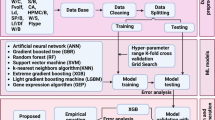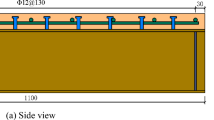Abstract
The use of steel fiber reinforced concrete (SFRC) as a structural material has shown an ever-increasing growth. Steel fibers have a significant effect on the mechanical properties of reinforced concrete, especially on its tensile behavior. For SFRC modeling, it is necessary to determine the stress–strain equations. Due to the complexity of strain–strain tests and the lack of access to these results before modeling and design, determining these equations without testing is a modeling requirement. So far, limited studies have been conducted on estimating the SFRC tensile stress–strain equation based on other SFRC characteristics. In this study, the results of 41 experimental specimens collected from the literature are used to present an equation to estimate the SFRC tensile stress–strain diagrams using the genetic programming (GP) method. The proposed equation had acceptable accuracy compared to the experimental results and other equations presented in the literature.









Similar content being viewed by others
References
Abrishami, H. H., & Mitchell, D. (1997). Influence of steel fibers on tension stiffening. Structural Journal, 94(6), 769–776.
Afroughsabet, V., Biolzi, L., & Ozbakkaloglu, T. (2016). High-performance fiber-reinforced concrete: A review. Journal of Materials Science, 51(14), 6517–6551.
Ahmed, S. F. U., & Maalej, M. (2009). Tensile strain hardening behaviour of hybrid steel-polyethylene fibre reinforced cementitious composites. Construction and Building Materials, 23(1), 96–106.
Deluce, J. R. (2011). Cracking behaviour of steel fibre reinforced concrete containing conventional steel reinforcement. MASc thesis, University of Toronto, Toronto, Canada.
Ding, Y. N., & Yan, Y. C. (2011). Experimental investigation on uniaxial tensile properties of steel fiber reinforced concrete. Applied Mechanics and Materials, 94, 731–735.
Hameed, R., Sellier, A., Turatsinze, A., & Duprat, F. (2013). Metallic fiber-reinforced concrete behaviour: Experiments and constitutive law for finite element modeling. Engineering Fracture Mechanics, 103, 124–131.
Hassan, A., Jones, S., & Mahmud, G. (2012). Experimental test methods to determine the uniaxial tensile and compressive behaviour of ultra high performance fibre reinforced concrete (UHPFRC). Construction and Building Materials, 37, 874–882.
Iranian, C. C. (2005). Design and analysis rules of concrete structures. Tehran: Management and Planning Organization of Iran.
Koza, J. R. (1992). Genetic Programming: On the Programming of Computers by Means of Natural Selection. MIT Press, Cambridge, MA.
Laskar, A., & Talukdar, S. (2008). Rheology of steel fiber reinforced concrete. Asian Journal of Civil Engineering (Building and Housing), 9(2), 167–177.
Li, F., & Li, Z. (2001). Continuum damage mechanics based modeling of fiber reinforced concrete in tension. International Journal of Solids and Structures, 38(5), 777–793.
Li, Z., Li, F., Chang, T. P., & Mai, Y.-W. (1998). Uniaxial tensile behavior of concrete reinforced with randomly distributed short fibers. Materials Journal, 95(5), 564–574.
Lin, Z., & Li, V. C. (1997). Crack bridging in fiber reinforced cementitious composites with slip-hardening interfaces. Journal of the Mechanics and Physics of Solids, 45(5), 763–787.
Mathew, B. A., Sudha, C., Rajkumar, P. K., & Ravichandran, P. (2015). Investigations on tensile properties of high strength steel fibre reinforced concrete. Indian Journal of Science and Technology, 8(28), 1–6.
Meng, Y., Chengkui, H., & Jizhong, W. (2006). Characteristics of stress-strain curve of high strength steel fiber reinforced concrete under uniaxial tension. Journal of Wuhan University of Technology-Material Science Ed, 21(3), 132–137.
Mihai, I. C., Jefferson, A. D., & Lyons, P. (2016). A plastic-damage constitutive model for the finite element analysis of fibre reinforced concrete. Engineering Fracture Mechanics, 159, 35–62.
Moradi, M., Bagherieh, A., & Esfahani, M. R. (2016). Relationship of tensile strength of steel fiber reinforced concrete based on genetic programming. International Journal of Optimization in Civil Engineering, 6(3), 349–363.
Moradi, M., Bagherieh, A., & Esfahani, M. R. (2018). Damage and plasticity constants of conventional and high-strength concrete part II: Statistical equation development using genetic programming. International Journal of Optimization in Civil Engineering, 8(1), 135–158.
Naaman, A. E., Namur, G. G., Alwan, J. M., & Najm, H. S. (1991). Fiber pullout and bond slip. I: Analytical study. Journal of Structural Engineering, 117(9), 2769–2790.
Silva, S., & Almeida, J. GPLAB-a genetic programming toolbox for MATLAB. In Proceedings of the Nordic MATLAB conference, 2003 (pp. 273-278): Citeseer
Sorelli, L., Meda, A., & Plizzari, G. (2005). Bending and uniaxial tensile tests on concrete reinforced with hybrid steel fibers. Journal of Materials in Civil Engineering, 17(5), 519–527.
Sujivorakul, C. (2012). Model of hooked steel fibers reinforced concrete under tension. In G. J. Parra-Montesinos, H. W. Reinhardt, A. E. Naaman (Eds.), High performance fiber reinforced cement composites 6. RILEM State of the Art Reports, vol. 2 (pp. 19–26). Dordrecht: Springer.
Suwannakarn, S. W. (2009). Post-cracking characteristics of high performance fiber reinforced cementitious composites. PhD Thesis, University of Michigan.
Wille, K., El-Tawil, S., & Naaman, A. (2014). Properties of strain hardening ultra high performance fiber reinforced concrete (UHP-FRC) under direct tensile loading. Cement and Concrete Composites, 48, 53–66.
Xu, L., Huang, L., Chi, Y., & Mei, G. (2016). Tensile behavior of steel-polypropylene hybrid fiber-reinforced concrete. ACI Materials Journal, 113(2), 219–229.
Zhan, Y., & Meschke, G. (2014). Analytical model for the pullout behavior of straight and hooked-end steel fibers. Journal of Engineering Mechanics, 140(12), 1–13.
Author information
Authors and Affiliations
Corresponding author
Ethics declarations
Conflict of interest
On behalf of all authors, the corresponding author states that there is no conflict of interest.
Rights and permissions
About this article
Cite this article
Moradi, M., Bagherieh, A.R. & Esfahani, M.R. Tensile modeling of steel fiber reinforced concrete. Asian J Civ Eng 20, 269–280 (2019). https://doi.org/10.1007/s42107-018-00104-y
Received:
Accepted:
Published:
Issue Date:
DOI: https://doi.org/10.1007/s42107-018-00104-y




